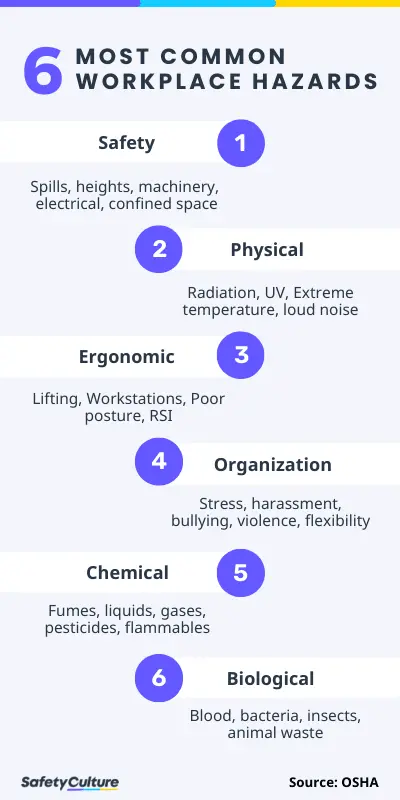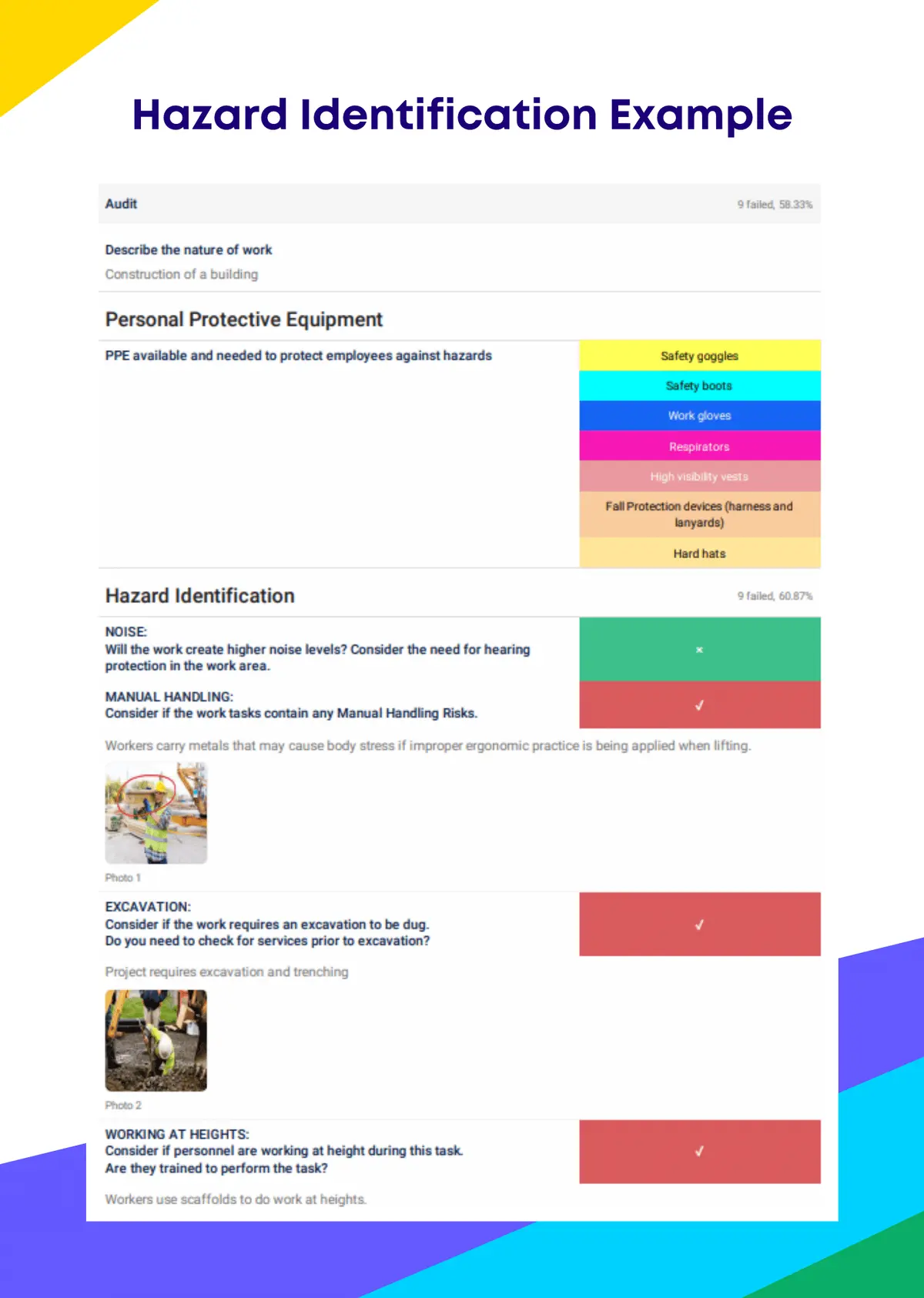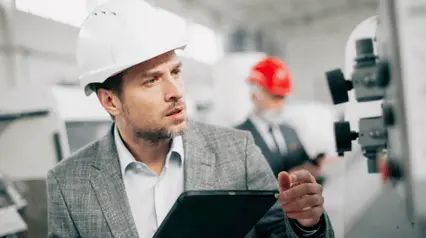What are Workplace Hazards?
Workplace hazards are the sources of potential harm or damage to someone or something in any work environment. It can be material or any activity that has the likelihood to cause injuries under specific conditions. It should be eliminated as soon as they are identified to prevent workplace incidents or fatalities.
The 6 Most Common Types of Workplace Hazards and Their Examples
Workplace hazards can be overlooked since the business is not aware of them. Identifying workplace safety issues can help prevent the likelihood of workplace incidents, accidents, or near-misses. OSHA identifies the 6 most common hazards in the workplace as follows:

1. Safety
A safety hazard is the most common type of hazard that is always present in a construction site. It includes unsafe working conditions that can cause injury, illness, or death. Here are the basic examples safety hazards in the workplace:
- Spills on floors or tripping hazards such as blocked aisles or cords running across the floor;
- Working from heights including ladders, scaffolds, roofs, or any raised work area;
- Unguarded machinery and moving machinery parts; guards removed or moving parts that a worker can accidentally touch;
- Electrical hazards like frayed cords, missing ground pins, improper wiring;
- Confined spaces; and
- Equipment and machinery-related hazards (lockout tagout, boiler safety, forklifts, hand, and power tools, etc.)
2. Biological
Biological hazards associated with working with animals, people, or infectious plant materials. Most at-risk workers include those who work in schools, daycare facilities, colleges and universities, hospitals, laboratories, emergency response, nursing homes, and outdoor occupations. Here are the types of biological hazards workers may be exposed to:
- blood and other body fluids;
- fungi/mold;
- bacteria and viruses;
- insect bites; and
- animal and bird droppings.
Browse our guide on the specific biological hazard examples along with the biohazard levels associated with them.
3. Chemical
Chemical hazards are present when a worker is exposed to any chemical preparation in the workplace in any form (solid, liquid, or gas). Chemicals can be safer to others, but to some sensitive workers, even the most common solutions can cause illness, skin irritation, or breathing problems. Workers should be aware of the following examples chemical hazards in the workplace.
- Liquids like cleaning products, paints, acids, solvents – especially if chemicals are in an unlabeled container;
- Vapors and fumes that come from welding or exposure to solvents;
- Gases like acetylene, propane, carbon monoxide, and helium;
- Flammable materials like gasoline, solvents, and explosive chemicals; and
- Pesticides.
Browse here for free safety checklists you can use to manage chemical hazards
4. Ergonomic
Ergonomic hazards occur when the type of work, body positions, and working conditions put a strain on the body. They are the hardest to spot since you don’t always immediately notice the strain on the body and the harm that these hazards pose. Short-term exposure may result in “sore muscles” the next day or in the days following exposure while long-term exposure can result in serious long-term illnesses. Ergonomic hazards include the following:
- Improperly adjusted workstations and chairs;
- Frequent lifting;
- Poor posture;
- Awkward movements, especially if they are repetitive;
- Repeating the same movements over and over;
- Having to frequently use too much force; and
- Vibration.
Learn more about ergonomics in the workplace and 10 simple ergonomic principles to follow. Also, browse for these free ergonomic assessment checklists.
5. Work Organization
Work organization hazards are stressors that cause psychosocial hazards such as tension, anxiety, or strain to workers. These can be experienced in short term (stress) or long term (strain) that is associated with workplace issues such as workload, lack of control and/or respect, etc. Here are work organization hazards examples:
- Workload demands;
- Workplace violence;
- Intensity and/or pace;
- Respect (or lack of);
- Flexibility/Control or say about things;
- Social support/relations; and
- Sexual harassment.
6. Physical
Physical hazards are factors within the environment that can harm the body without necessarily touching it. Examples of physical Hazards include the following:
- Radiation: including ionizing, non-ionizing (EMF’s, microwaves, radio waves, etc.);
- Prolonged exposure to sunlight/ultraviolet rays;
- Temperature extremes – hot and cold; and
- Constant loud noise (which can be a harmful hazard if not well-managed or mitigated).
Employers, managers, and safety officials can reduce common workplace hazards by establishing adequate safety protocols, hazard identification procedures, and conducting regular hazard assessments.
One of the most affected part of the body when it comes to hazards are our hands. In some cases, it is also mostly responsible for triggering hazards in the workplace. Hand safety should be observed by people in the workplace to avoid injuries and accidents.
What is Hazard Identification?
Hazard identification is a risk assessment practice that aims to identify and record safety risks and work hazards to ensure the safety of workers and personnel. Hazard identification is usually done:
- when new processes, equipment, and/or machinery are introduced into the standard workflow;
- before each shift;
- in the performance of work;
- during formal or informal inspections; and
- after incidents occur.
The National Institute for Occupational Safety and Health (NIOSH) also developed the hierarchy of controls to guide workplaces in implementing effective hazard control measures.
Benefits
It is the employer’s responsibility to inform, educate, and train their employees about workplace hazards. It is paramount to ensure a safe and healthy environment not just for employees but for clients as well. Early detection of hazards and implementing safety practices will help the business in achieving its goals. It would also help:
- prevent numerous work-related injuries and illnesses;
- improve compliance with laws and regulations;
- reduce costly repairs and unexpected damages;
- improve employee engagement, productivity, and efficiency; and
- boost overall business operations.
How to Identify (with Example of Hazard Identification)
Failure to spot hazards can often lead to serious injuries and dangers in the workplace. All safety and health checklists and programs must consistently identify and assess hazards to ensure that all workers are safe and protected.
A hazard identification procedure is done through a collaborative effort of employers and workers. A step-by-step procedure could be as follows:
- Gather information about existing hazards that are likely to be present in the workplace. Below is a hazard identification example that can be used serve as a template or reference:

- Perform regular site walkthroughs to identify new hazards.
- Review accidents and near-miss logs to further investigate the root causes and program shortcomings. Browse free incident report templates.
- Identify similar trends across all incidents, illnesses and hazards recorded. Also, consider hazards that are present on non-routine jobs.
- Determine the level of risk, significance, and frequency of each hazard to know which needs to be prioritized. Download free risk assessment templates.
Create your own Hazard Identification checklist
Build from scratch or choose from our collection of free, ready-to-download, and customizable templates.
Browse Hazard Identification checklistsA Tool to Spot Hazards Easily
A traditional pen and paper-based hazard assessment involve carrying around numerous paperwork and a camera to manually document the identified hazard in the facility. This process involves a manual compilation of gathered data that is cumbersome and prone to errors. These hassles can be avoided with SafetyCulture (formerly iAuditor) an inspection software and mobile app solutions.
With SafetyCulture users can perform safety audits and hazard assessments quickly and accurately using a mobile device. An in-app capturing of identified hazards and assigning corrective actions to appropriate persons can streamline the reporting processes to immediately address the issues.
Improve your GRC management
Simplify risk management and compliance with our centralized platform, designed to integrate and automate processes for optimal governance.
Explore nowStay Safe at Work with Digital Workplace Hazard Procedures and Instructions
Workplace hazard policies and instructions are like the rulebook for your workers. They show them how to stay safe and keep the workplace hazard-free. But how do you make sure they actually follow these guidelines? The answer is simple: equip them with effective workplace hazards training.
Good training is the key to reinforcing the best procedures and instructions. Not only does it help your workers be more aware of potential hazards and be proactive in preventing accidents, but it also improves their quality of work and boosts their productivity.
Creating effective training is now quick and easy, thanks to the increase in Training tools and technology today. With just a click, you can transform your policies and procedures into engaging training that your team will benefit, from start to finish.
FAQs About Workplace Hazards
As a general rule, workplace hazards should be reviewed and updated at least once a year, or whenever significant changes occur in the work environment or processes. This may include changes in equipment, materials, or work procedures, as well as changes in regulations or safety standards.
It is the responsibility of employers to identify and control workplace hazards. Employers have a legal and moral obligation to ensure a safe and healthy work environment for their employees. Likewise, employees should also be encouraged and trained to increase their awareness of hazards and how to prevent them.
The role of management in addressing workplace hazards is to establish procedures and policies that employees can follow. They should also promptly investigate and take action to address reported hazards, as well as provide necessary training and resources to increase workers’ knowledge and enable them to protect themselves.
Workplace hazards can have a variety of negative effects on both employees and employers. Some of these effects include increased chances of injuries or illnesses, reduced employee morale, legal consequences, and damage to reputation. This emphasizes the importance of proactively identifying and mitigating these hazards before they significantly impact and interrupt operations.




